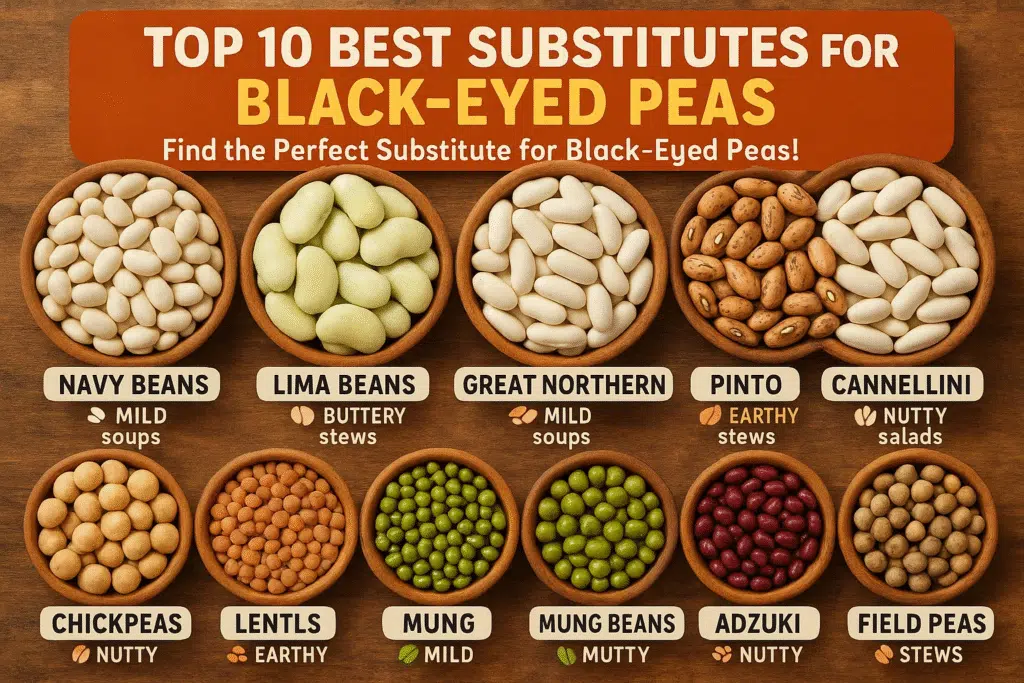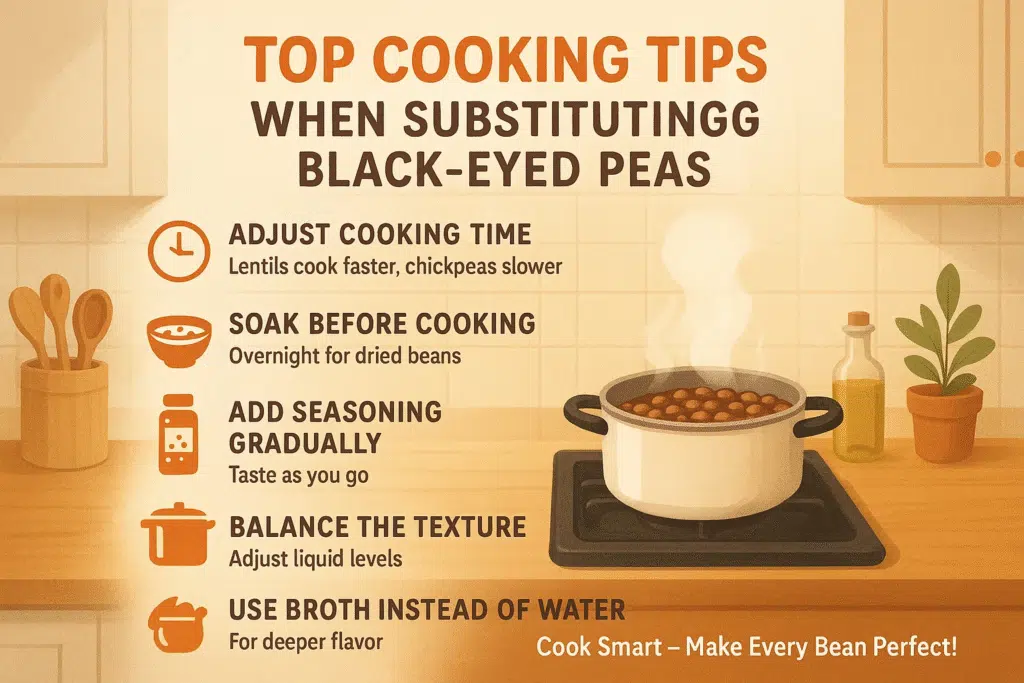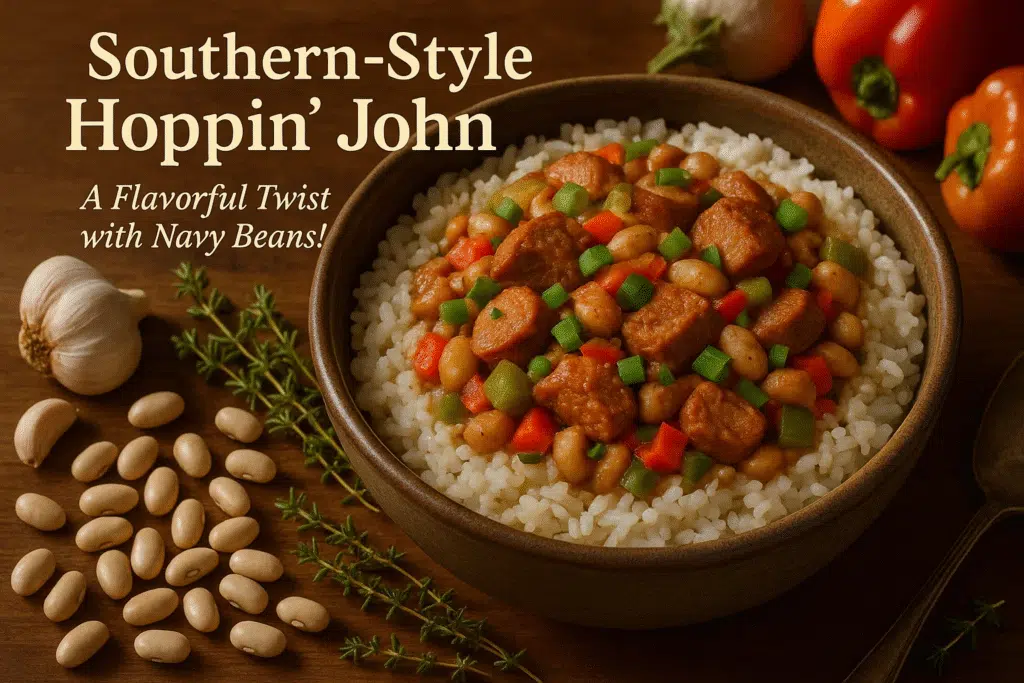Ultimate Black-Eyed Peas Replacement List for 2026
You have a recipe that requires black-eyed peas, but you do not have them in your pantry? Don’t worry! I’ve got you covered. In this guide, I will provide the best black-eyed pea alternatives, their distinct textures, and tastes as well as the way of using them in the most appropriate dishes.
You can prepare soups, stews, salads or even traditional Southern recipes such as Hoppin John and identify incredible alternatives that do not lose the taste and healthiness. Let’s explore everything in detail!
What Are Black-Eyed Peas?
Cowpeas or black-eyed peas are small and are creamy-white beans with a black spot or eye. I tend to call them creamy, well-built and a bit crunchy. They are consumed in Southern, African and Indian dishes, when prepared in stews, curries, salads and side meals.
Nutritional Value
The black eyed peas are not only tasty but also has a high amount of nutrients therefore making it an excellent ingredient in a balanced diet. Here’s what you’ll get from 1 cup (about 165 grams) of cooked black-eyed peas:
- Calories: 160
- Protein: 13 grams
- Carbohydrates: 35 grams
- Fiber: 11 grams
- Fat: 0.5 grams
- Iron: 2.2 mg
- Potassium: 475 mg
- Folate: 90% of the daily requirement
They are a good source of plant proteins and therefore are good among vegans and vegetarians. Moreover, they have a lot of fiber which is healthy in digestion and heart.

Why Look for a Substitute?
Why, you might be wondering, would you ever have an alternative to the black-eyed peas? The main causes why I frequent are as follows:
- Availability Issues: The availability of black-eyed peas depends on the location/store.
- Texture/ Tastes Preferences: One likes the creamier or harder texture; that is, according to the recipe.
- Eating Detentions: You might wish to have another set of beans that might be more beneficial to your nutritional needs or diet.
- Experimentation: Sometimes, you just want to try something new while maintaining similar nutrition and flavor.
Then, in that case, you cannot use black-eyed peas; there are simply too many great options to make your recipes just as tasty and healthy.
Top 10 Best Substitutes for Black-Eyed Peas
I would recommend the 10 best substitutes as shown below, and each of them has its own texture, taste, and the best recipe.
1. Navy Beans
Flavor: Mild and slightly nutty
Texture: Soft and creamy when cooked
I like Navy beans as one of my favorite alternatives that go well with the soup, stews, and casseroles. They absorb seasoning, and they emulate the creaminess of black eyed peas.
Best For:
- Soups and stews
- Casseroles
- Pureed bean dips
2. Lima Beans (Butter Beans)
Flavor: Buttery and slightly sweet
Texture: Creamy and smooth
In case you would like it richer and creamier, the possible alternatives are lima beans. They make the food creamy and can be used to complement the Southern-style foods very well.
Best For:
- Southern side dishes
- Creamy soups
- Vegan stews
3. Great Northern Beans
Flavor: Mild and delicate
Texture: Firm yet tender
I also tend to recommend Great Northern beans to be used in recipes in cases where the taste of a mild bean is needed, but the rest of the ingredients should not be overwhelmed. They go well with slow-cooked meals.
Best For:
- Vegetable soups
- Bean salads
- White chili
4. Pinto Beans
Flavor: Earthy and slightly sweet
Texture: Soft and mashable
The pinto beans are easily accessible and can be utilized in most of the recipes that need the black eyed peas. They offer a homey feel with a taste that is easy, homely, and perfect with Tex-Mex and comfort foods.
Best For:
- Chili and burritos
- Stews
- Mashed bean sides
5. Cannellini Beans
Flavor: Mild and slightly nutty
Texture: Creamy yet firm
Another good substitute is cannellini beans (synonyms: white kidney beans) that do not lose their shape but instead offer an excellent, smooth, and gratifying texture.
Best For:
- Mediterranean salads
- Soups
- Pasta dishes
6. Chickpeas (Garbanzo Beans)
Flavor: Nutty and grainy
Texture: Firm and chewy
An equivalent is a substitute that is close and rich in protein that replaces the chickpeas. They work best when you need more bite and a denser texture.
Best For:
- Curries
- Roasted snacks
- Grain bowls and salads
7. Lentils
Flavor: Earthy and hearty
Texture: Soft, varies by type (green, brown, red)
I would choose lentils as a fast and fiberous vegetarian substitute. They are faster than beans and take up well in the weekday meal.
Best For:
- Curries and stews
- Soups
- Side dishes
8. Mung Beans
Flavor: Mild and slightly sweet
Texture: Soft yet firm
Mung beans also do the trick when you are feeling like having a light yet low-protein alternative. They are also common in Asian food and are reportedly simple to digest.
Best For:
- Curries
- Salads
- Stir-fries
9. Adzuki Beans
Flavor: Sweet and nutty
Texture: Firm but smooth
The adzuki beans may be used in case you would like a sweeter taste in your dishes. They are served as an ingredient in both savoury and sweet dishes, especially in East Asian cuisine.
Best For:
- Rice dishes
- Soups
- Sweet bean pastes
10. Field Peas or Crowder Peas
Flavor: Earthy and rich
Texture: Slightly firm
These are close relatives of the black eyed peas, and they have nearly the same taste. When you are able to find them, then they would be the closest, which you can get.
Best For:
- Traditional Southern dishes
- Stews and soups
- Hoppin’ John

How to Choose the Best Substitute
Choosing the right substitute depends on what you’re cooking. Here’s how I recommend deciding:
| Recipe Type | Best Substitute Options |
| Soups & Stews | Navy beans, Great Northern beans, lentils |
| Salads | Chickpeas, Cannellini beans, Adzuki beans |
| Southern Dishes | Lima beans, Field peas, Pinto beans |
| Curries & Spicy Foods | Chickpeas, Lentils, Mung beans |
| Creamy Dishes | Lima beans, Cannellini beans, Navy beans |
When in doubt, go with Navy beans; they’re mild, soft, and versatile enough for almost any recipe that uses black-eyed peas.
Cooking Tips When Substituting
To ensure the texture and flavor turn out fine, I constantly use a few basic rules when working with substitutes:
- Adapt Cooking Time: There are those beans (such as lentils) that cook within a shorter period and those that require more time (such as chickpeas).
- Soak Before Cooking: To use dried beans, one has to soak them overnight in order to reduce the cooking time and enhance digestion.
- Add Seasoning Gradually: Substitute beans may absorb salt and spices differently taste as you go.
- Adjust Texture: In case your alternative is firmer or softer, add more or less liquid to your recipe.
- Use Broth Instead of Water: This enhances flavor and gives your dish a deeper taste profile.

Sample Substitution Recipe
Southern-Style Hoppin’ John (Using Navy Beans)
In case you are not able to locate black-eyed peas, this hoppin’ John with navy beans is the most ideal sub-recipe of the South!
Ingredients:
- 1 cup navy beans (soaked overnight)
- 1 cup long-grain rice
- 1 onion (chopped)
- 1 bell pepper (chopped)
- 2 garlic cloves (minced)
- 1 cup smoked turkey or vegan sausage
- 4 cups chicken or vegetable broth
- Salt and pepper to taste
- 1 tsp paprika
- 1 tsp thyme
Instructions:
- Sauté the onion, pepper, and garlic in a big pot.
- Also add in the smoked turkey (or vegan sausage) and cook for a few minutes.
- Add the soaked navy beans and the broth.
- Add seasonings, salt, pepper, paprika, and thyme.
- Cook approximately 1 hour or till the beans are tender.
- Add cooked rice and mix well.
- Serve hot, topped with green onions.

This version keeps the classic soul of Hoppin’ John while using a more accessible substitute that tastes just as comforting and hearty.
FAQS ( Frequently Asked Questions)
Got questions about black-eyed pea substitutes? I’ve answered the most common ones below to help you cook smarter and discover the perfect bean alternative for your recipes! Don’t stop here, your next favorite ingredient might be on this list! Find out which substitute will make your dish even more delicious
1. What can I use instead of black-eyed peas in recipes?
You can use navy beans, lima beans, chickpeas, or lentils as excellent substitutes. Their taste, consistency, and nutritive value are identical to black eyed peas.
2. Which bean tastes closest to black-eyed peas?
The most resembling are the field peas or navy beans. They are light, smoky, and will roast to a soft and creamy texture that is perfect in Southern dishes.
3. Substitutes for black-eyed peas would be lentils?
Yes! Lentils can be cooked within a short period of time, and they have a savory flavor. They are great in soups, stews, and curries when you are too lazy to have something healthy.
4. Are chickpeas a good substitute for black-eyed peas?
Absolutely! Chickpeas are rich in protein, and they have a nutty taste. They go best in salads, curries, and other dishes of the Mediterranean orientation.
5. Which substitute is best for Southern-style recipes like Hoppin’ John?
I would make a suggestion of navy beans or field peas, just in case it is an antique recipe. They match with rice, spices, and smoked like the black eyed beans.
6. Are black-eyed pea substitutes healthy?
Yes, these lentil substitutes of lima beans are very high in fiber and protein and other vital nutrients. You shall also be reaping the same health benefits.
Final Words
Black eyed peas are not just ordinary, even though their substitutes are the opening to the world of taste, creativity, and health. You may choose either navy beans instead of an ordinary dish, or lentils instead of a fast dish, or even chickpeas instead of more protein, but something has made its way to your kitchen.
There can never be an excuse for not having an ingredient. Cook, in every dish, learn new things, experiment. Each option has its story, taste, and nutritional benefits to offer to make your food both interesting and healthy.

